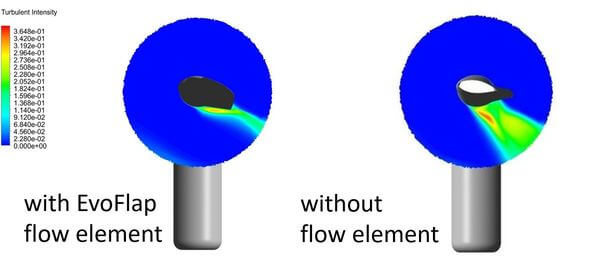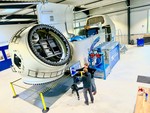News Release from Deutsche Windtechnik Ltd.
Wind Industry Profile of
evoblade and Deutsche Windtechnik develop trailing edge spoilers for rotor blades – study confirms flow improvement, load reduction and positive effect on entire service life
The results of a side-by-side study of testing and optimising the EvoFlap now confirm that installing the spoiler can improve the aerodynamic flow in the area of the blade root, resulting in improved efficiency and performance of the system.
"Rotor blades have a significant impact on the technical and economic performance of a wind turbine," said Dr.-Ing. Frank Kortenstedde, founder and CEO of evoblade. "By developing and optimising a retrofittable flow element, we wanted to achieve a technical and economic improvement in the properties of existing systems that leverages the advances in technical understanding." Matthias Brandt, Director of Deutsche Windtechnik AG, added: "Even though retrofitting flow elements is not always an option, and the initial design and features of turbines are up to the system manufacturers, we are still very happy to participate in and support research projects like this that look at technologies of the future. The results are moving in the right direction and are helping the entire industry!"
Side-by-side study design with iSpin performance monitoring
The EvoFlap can be adapted to different rotor blade types. The NEG Micon NM 82 turbine type with a rated output of 1.5 MW and a rotor blade length of 40 m was selected as the basic system for the optimisation. The flow element was developed using the GFRP sandwich technique and has an overall length of 10 m. It is divided into seven segments to allow assembly directly on an installed rotor blade. "The blade does not have to be removed from the hub to allow EvoFlap to be installed, and this reduces the amount of work and costs," Frank Kortenstedde emphasised. "Also, the blade structure is not damaged by gluing the segments onto it, and the EvoFlap blends harmoniously with the blade design." To validate the annual energy output, the company ROMO Wind was commissioned to carry out independent performance monitoring using iSpin spinner anemometer technology. Measuring the wind speed in front of the turbine has the advantage that the reference wind speed is measured directly and undisturbed. In addition to the test system, a second (adjacent) turbine of the same type was equipped with iSpin technology as a reference system.

Sectional view of the rotor blade looking at the nacelle from above, showing the reduced turbulence intensity with EvoFlap. (Photo: Deutsche Windtechnik)
Six percent additional yield and positive effect on service life
The results of the side-by-side study (project duration 08/2015 - 03/2019) confirmed the increase in AEP (annual energy production) that had been predicted using simulated data. Recent results also show a six percent increase in AEP with an average annual wind speed of 7 m/s. In addition to increasing the yield, it was demonstrated that the EvoFlap also increases the bending and torsion strength of the rotor blade, and this has a positive effect on the service life of the blade. "Depending on the useful life of the EvoFlap, a possible extension of 1.2 to 2.6 years beyond the maximum service life of 20 years can be achieved," Frank Kortenstedde explained. "A very high level of technology transfer has been achieved. Retrofitting such large-scale flow elements is currently the absolute exception. Nevertheless, this research project shows significant potential positive effects."
The EvoFlap can theoretically be installed on all wind turbines that have a slender design in the area of the blade root. The flow element is suitable as a retrofit solution or for manufacturers of wind turbines, but it needs to be adapted to the individual characteristics of the corresponding blade type.
- Source:
- Deutsche Windtechnik
- Author:
- Press Office
- Link:
- www.deutsche-windtechnik.com/...
- Keywords:
- Deutsche Windtechnik, evoblade, iSpin, rotor blade, study, spoiler, load reduction, wind turbine, Bremen, University, IAT, technical, retrofit
























